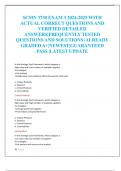SCMN 3730 EXAM 3 2024-2025 WITH
ACTUAL CORRECT QUESTIONS AND
VERIFIED DETAILED
ANSWERS|FREQUENTLY TESTED
QUESTIONS AND SOLUTIONS |ALREADY
GRADED A+|NEWEST|GUARANTEED
PASS |LATEST UPDATE
In the Strategic Cost framework, which category is
High value with Low number of available suppliers
Its strategies:
-Cost analysis
-Collaborative cost-reduction efforts focused on total costs
a. Unique Products
b. Generics
c. Critical Products
d. Commodities
Critical Products
In the Strategic Cost framework, which category is
High value with High number of available suppliers
Its strategies:
-Leverage preferred suppliers
-Price analysis using market forces
a. Unique Products
b. Generics
c. Critical Products
d. Commodities
Commodities
In the Strategic Cost framework, which category is
Low value with Low number of suppliers
Its strategies:
-Cost analysis and reverse price analysis
1|Page
,-Standardize requirements
a. Unique Products
b. Generics
c. Critical Products
d. Commodities
Unique Products
In the Strategic Cost framework, which category is
Low value with High number of available suppliers
Its strategies:
-Total delivered cost
-Automate to reduce purchasing involvement
a. Unique Products
b. Generics
c. Critical Products
d. Commodities
Generics
______________ is an analytical tool that identifies the primary external forces that are causing prices
to either increase or decrease
Market Analysis
When demand exceeds supply, a _______ market exists, and prices generally _________
a. buyer's, increase
b. buyer's, decrease
c. seller's, increase
d. seller's, decrease
seller's, increase
When supply exceeds demand, a _________ market exists, and prices generally _________
a. buyer's, increase
b. buyer's, decrease
c. seller's, increase
d. seller's, decrease
Buyer's, decrease
These are conditions favorable to __________:
1. High level of capacity utilization
2. Tight supply
3. Strong demand
2|Page
,a. supplier
b. buyer
c. consumer
Supplier
These are conditions favorable to ____________:
1. Low level of capacity utilization
2. High level of supply
3. Weak demand
a. supplier
b. buyer
c. consumer
Buyer
______________ requires a purchaser to identify and measure costs beyond the standard unit price,
transportation, and tooling even when evaluating purchase proposals. It is defined as the present value
of ALL COSTS associated with a product, service, or capital equipment that are incurred over its
expected life
Total Cost of Ownership (TCO)
There are four major elements for total cost of ownership (TCO). Based on the definition given, pick the
term that goes with it.
Invoice amount paid to supplier
--> Hardware, Software licenses A, B, and C
a. end-of-life costs
b. purchase price
c. acquisition costs
d. usage costs
purchase price
There are four major elements for total cost of ownership (TCO). Based on the definition given, pick the
term that goes with it.
Costs of bringing product to buyer
--> sourcing and administration
a. end-of-life costs
b. purchase price
c. acquisition costs
d. usage costs
3|Page
, acquisition costs
There are four major elements for total cost of ownership (TCO). Based on the definition given, pick the
term that goes with it.
Conversion and support costs
--> installation, equipment support, network support, warranty, opportunity costs - lost productivity
a. end-of-life costs
b. purchase price
c. acquisition costs
d. usage costs
usage costs
There are four major elements for total cost of ownership (TCO). Based on the definition given, pick the
term that goes with it.
Net of amounts received/spent at salvage
--> Salvage value
a. end-of-life costs
b. purchase price
c. acquisition costs
d. usage costs
end-of-life costs
T/F:
A Should Cost Analysis can be used when supplier is reluctant to share its internal cost data. It breaks
down cost into basic components: Materials, Labor, and Overhead
True
There are 3 main cost components in a Should Cost Analysis, which term goes best with the definition of
one?
Commodity price fluctuations, handling difficulties, tolerances, lead times, design limitations, managed
flow, cost of poor quality
a. Materials
b. Labor
c. Overhead
Materials
There are 3 main cost components in a Should Cost Analysis, which term goes best with the definition of
one?
Direct labor cost, process complexity, safety concerns, scrap, efficiencies, turnover, correction, cost of
4|Page




